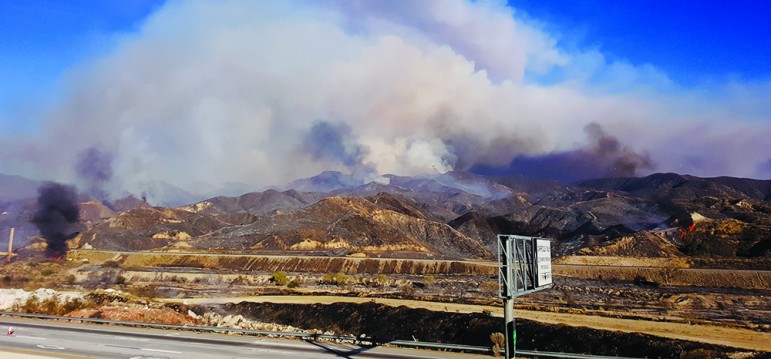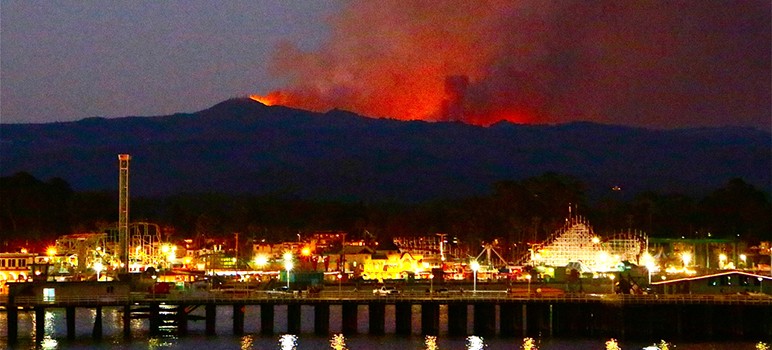On a late September afternoon, residents as far flung as San Jose, Morgan Hill and Santa Cruz watched in collective horror as a thin smoke plume at the summit of the Santa Cruz Mountains became an ominous mushroom cloud that was visible for miles.
For two weeks, the mountain peak looked like an erupting volcano as the Loma fire burned 4,474 acres and destroyed 12 homes and 16 other buildings. Hundreds were evacuated.
At its height, more than 2,000 personnel battled the fire day and night, from the air and on land. The Loma fire was contained on Oct. 10, but firefighters remained at the scene for another several days, finishing repairs. Not including damages to property and infrastructure, more than $17.8 million was spent to control it, according to Cal Fire staff.
In fact, much of California was ablaze this summer. In August, the Blue Cut fire near Los Angeles burned more than 36,000 acres. The Soberanes fire in Big Sur, which began July 22, burned for nearly three months, consuming 132,127 acres. Last month, the state had 43 wildfires. And yet, fire season is just beginning—in the Santa Cruz Mountains, fall brings prime conditions for wildfires—parched vegetation, less fog and dry north winds.
It’s not just the number of wildfires that’s startling, but also their intensity. Wildfires now burn twice as many acres as they did 30 years ago, and scientists expect that figure to double again in the next 30 years. Fire seasons are also three months longer than they were in the 1970s, according to a 2015 U.S. Forest Service report. As California’s wildfires grow bigger and hotter, this summer’s explosive blazes may be a sign of what’s to come.
The New Normal
The two largest fires ever recorded on the Central Coast both happened in the last decade. One of them, the Zaca fire near Santa Barbara in 2007, was particularly intense, burning all vegetation to the ground and leaving nothing over roughly 170,000 acres, says Chris Potter, a research scientist at NASA who studies wildfires and the Santa Cruz Mountain forests.
“So if that’s an indicator or representative of what’s to come for the kind of fires we’re going to have in the future, they’re going to be difficult to control, burning larger areas, in really remote kinds of terrain that makes it very difficult for firefighters,” Potter says.
All the research points to a single overwhelming factor behind the frequency and size of California’s wildfires, says Potter: air temperature. Hot days often come with low humidity and wind, which makes flames burn hotter and faster. And only a few hot, dry days are needed to prime an ignition.
“It’s just perfect for spreading fire. Hot, and then a little bit of wind, and you’ve got yourself a huge problem,” Potter says.
Climate change from fossil fuels and the buildup of greenhouse gases is making wildfires more dangerous, he says. The warming trend has already increased the frequency of fires on the Central Coast. Huge wildfires like the Soberanes fire used to occur every 25 to 30 years. Now they come once a decade.
“Because we’ve changed the climate here, that’s our new normal. That’s what you have to expect, and what you have to prepare for,” Potter says. “Not only will they be bigger than ever, but they’ll burn hotter, with more severity. So it will be hard to save structures that are within their pathway. We’re already spending $1 billion per year to control fire in the state. So the more you can do to not stay in the way and not build in remote places, the better off we’ll be in protecting what we have in the mountains.”

The Sand Fire this July engulged thousands of acres near Santa Clarita. (Photo by PEIEQ, via Shutterstock)
Changing Times
Hot, dry days prime the ignition, but it’s vegetation that fuels wildfires. And over the past century, the plant communities of the Santa Cruz Mountains, which pass through Santa Clara and San Mateo counties, have seen drastic change.
If left unchecked, Santa Cruz Mountains grassland turns to shrubland, then to increasingly thick forest. Wildfires and grazing animals, and later, people, have kept the balance for most of the mountains’ history. First came the mastodons and mammoths—giant tusked beasts—which ate grass and leaves. Then for thousands of years, Native Americans managed the land with prescribed burns. In the 1800s, the timber and farming industries began thinning the forests, also with prescribed burns.
So historically, when wildfires started, as is natural for this region, they mostly burned a small area and died on their own, since they had relatively little fuel.
But since the 1900s, the Santa Cruz Mountains have been mostly unmanaged for the first time in history, creating a different, thicker forest, says David Van Lennep, a local forester for the Redwood Empire lumber company. Not only have prescribed burns become rare, but any wildfire that pops up is immediately suppressed.
“There’s more flammable material in the mountains now than there has been in past years. The fires that we’ve seen starting in 2008 in the Santa Cruz Mountains are kind of a new phenomenon,” Van Lennep says.
The Summit fire near Corralitos in 2008 was the last significant wildfire in the region, scorching 4,270 acres. It burned some dense areas that hadn’t seen fire in almost a century. Roughly 40 percent of the Santa Cruz Mountains is public land that is mostly unmanaged, said Van Lennep.
Tim Hyland, senior environmental scientist for the Santa Cruz district of California State Parks, says prescribed burns occur in less than 1 percent of the 65,000 acres of state land in San Mateo and Santa Cruz counties.
Prescribed burns are difficult in the Santa Cruz Mountains. For one, the Clean Air Act limits the amount of smoke that can be produced. Also, as more people move into the mountains, there’s a smaller area that can be burned safely, Hyland says.
A Disrupted Cycle
Natural wildfires and prescribed burns used to reset the landscape, creating patches where plants would clear then return, says Ed Orre, forester and division chief of Cal Fire’s Santa Clara unit.
That’s no longer the case. Fires are now extinguished as fast as possible.
“Because we’ve suppressed fire for so long, everything’s built up across the landscape, and now we have large expanses of heavy fuels and dry vegetation,” Orre says. “And so we’re not getting those smaller patch burns and maintaining that mosaic on the landscape. We’re getting bigger, larger fires. And when the weather is really hot and dry and the fire starts, it’s really difficult to catch.”
Orre started with Cal Fire in 2000, in the San Mateo-Santa Cruz unit. Within his first few years, he had already participated in eight of California’s top 20 most expensive and largest fires in history at the time, he says.
Orre said the Loma fire luckily had no significant wind, otherwise it would have grown much larger.
“It was a fuel-driven fire,” says Orre. “It was a very hot, dry day [when it started] and the fire was burning daytime and nighttime, very aggressively. We were very successful at keeping it from getting any bigger than it was, but it was a tough fire to put out, until the weather changed.”
The peak of the Santa Cruz Mountains fire season is only beginning, Orre says. Recent rains wet the grass, but were not enough to rehydrate the larger, thicker plants, which can still fuel fire, he says.
Weeds Win
Change how fires spread, and you change the plant community, says Hyland.
For example, the Santa Cruz Mountains are being swallowed by invasive plants, many of which are flammable. After the 2008 Summit fire, stinkwort and French broom took over places where they didn’t grow before. These invasive weeds specialize in spreading to newly burned places, and beat out the native species, says Hyland.
“They’re not good habitat for all the animal species. I like to refer to them as ‘empty calories’ in the ecosystem,” Hyland says. “They take up space, but they don’t contribute to the food pyramid.”
“So that’s really an issue. If we start seeing increased fires, which seems almost certain that we will and already are, then that puts us at risk for all these weeds to win out after the fires.”
The Santa Cruz Mountains are also overwhelmed by Douglas firs, says Hyland. These trees are flammable and historically have been controlled by wildfires. But because of fire suppression, Douglas firs are spreading at incredible rates, swamping out rare plant communities.
Forest managers are now removing Douglas firs and trying to preserve oaks, which are more fire resistant. The hope is that when fires become more frequent and intense, the forest will be more resilient, says Hyland.
Another problem facing forest managers is sudden oak death, which is widespread in the Santa Cruz Mountains. It’s a disease caused by a water mold, and has flared up in the last five years, says Shannon Lynch, a UC Santa Cruz doctoral student studying tree disease. She says it’s unclear how many oak trees are affected, but sudden oak death is the primary disease affecting local forests.
Contrary to the name, “it’s not a sudden death,” says Lynch. “It takes an estimated five years for a tree to actually die. When it’s attacked, it’s just those last several months that the tree appears healthy, apart from some bleeding symptoms on the trunk. But within a couple of weeks, all of a sudden the canopy changes, but it’s been running its course for a number of years on the tree,” Lynch says.
As sudden oak death kills more trees, it creates more possible fuel for fires, says Orre.
He urges mountain residents to “harden their homes” to fire. Homes are usually damaged by falling embers, not racing flames, he says. Orre recommends that they also install fireproof roofs and siding, keep gutters clean, cover chimneys and vents with metal mesh, replace single-paned and large windows with stronger ones, equip garages with fire extinguishers, and post address signs so they’re clearly visible from the road. Residents should clear a perimeter around their houses, he says.
“If people are going to be living in the wildland or on the edge of the wildland, they need to be as prepared as they can for the eventuality of a fire coming through,” Orre says.


> “Because we’ve changed the climate here . . . .”
WRONG. “We” haven’t changed the climate here.
A textbook example of pareidolioa.
“the imagined perception of a pattern or meaning where it does not actually exist, as in considering the moon to have human features”
https://en.wikipedia.org/wiki/Pareidolia
Wildfires are natural and have been going on for eons.
From the article:
Climate change from fossil fuels and the buildup of greenhouse gases is making wildfires more dangerous…
That’s errant nonsense. The primary “greenhouse gas” is carbon dioxide; CO2. You know, the same stuff used in fire extinguishers. And since fossil fuels have been in widespread use for more than a century, the recent upsurge in the number of fires must be due to another cause.
The real cause is most likely a few of the thousands of illegals flooding in from the Middle East. They know how easy it is to put a cigarette into a pack of matches to make an arsonist’s easy-peasy time-delayed forest fire igniter…
…but pointing out the obvious isn’t P.C., so science-challenged goofs like Chris Potter have to invent other reasons.